Welcome to another edition of Willoughby Hills!
This newsletter explores topics like history, culture, work, urbanism, transportation, travel, agriculture, self-sufficiency, and more.
If you enjoy what you’re reading, please consider a free subscribtion to receive emails every Wednesday and Sunday plus podcast episodes every two weeks. There are also paid options, which unlock even more features.
I’ve recently discovered that one of my favorite activities is going into an unknown kitchen and trying to cook a meal.
I’m actually late to publishing my usual Sunday newsletter because we closed on our new house on Friday and spent the weekend beginning to get situated and comfortable. For us, this meant getting familiar with the kitchen and cooking good meals with limited ingredients or supplies.
For some reason, we decided that the first meal in our new house should be a whole roasted chicken. My cousin and his wife were coming over for a few hours to help us move some furniture, plus we were spending the weekend in the house, and it seemed to make sense that a whole chicken would let us have more than enough food to feed everyone, plus leftovers for a few days that wouldn’t involve any cooking while we worked around the house.
Throughout the weekend, we continued to riff on the whole chicken, adding pieces to sandwiches, wraps, and more. I even saved the carcass to make soup.
As we worked in our new kitchen without our usual tools, we began to learn some of the quirks of the space- the burner on the stove that doesn’t light properly, the leaky faucet that needs to be positioned just right to not drip. We’re planning to renovate the kitchen soon, and it gave us a chance to really understand what’s working and what’s not.
Our new kitchen was actually the third new kitchen that we had to learn over the last week.
When we were in Hawai’i last week, we decided that we would rather cook our own food than eat out every meal in a restaurant. Some of this was dietary: since we started following the Plant Paradox way of eating more than two years ago, we notice that when we eat food out, we tend to not feel so great. Another consideration was financial, as we were closing on our new house as soon as we returned from vacation and knew we’d need to spend money on home improvement projects.
But perhaps the biggest motivation behind wanting to cook in rather than eat out in Hawai’i was that the islands have a bounty of fresh foods being grown by amazing farmers. Sadly, those local crops and other food products are not always easy to find. Even as we were eating locally grown avocados, the local Whole Foods on Oahu was selling ones grown in Mexico.
I was fortunate enough to have an “in” to the local farmer scene, which made our visit delicious, fresh, and healthy.
Back in 2017 while I was producing Ask This Old House, I got connected with the incredible MA’O Organic Farms, an amazing operation on Oahu which focuses on employing Native Hawaiians and using sustainable growing methods.
Before this recent trip, I reached out to Gary Maunakea-Forth, the cofounder and managing director of MA’O, hoping I might be able to purchase some of his crops and maybe even get connected to another local farmer or two for our trip.
The timing of getting produce directly from MA’O wasn’t going to work out, but Gary had a different suggestion. He recommended Farm Link Hawai’i to me, which is a delivery service on Oahu that sources produce, meat, and other local food products from small producers across the islands and delivers them to people’s doors.
My wife and I spent a few weeks drooling over the options: tons of fresh fruits including guava, pineapple, and avocados grown right in the islands. Fresh greens like lettuce and bok choy. Grass fed beef and local seafood. We were excited to see Okinawa sweet potato, one of the staples of the diet that makes Okinawa a “Blue Zone.” But even better was local Hawaiian specialities like ulu (breadfruit) and poi, which is a fermented paste made from taro root.
We added items to our Farm Link cart until we had spent a few hundred dollars. It seemed expensive in one stop, but we probably spent the equivalent of 2-3 restaurant meals on supplies for the week.
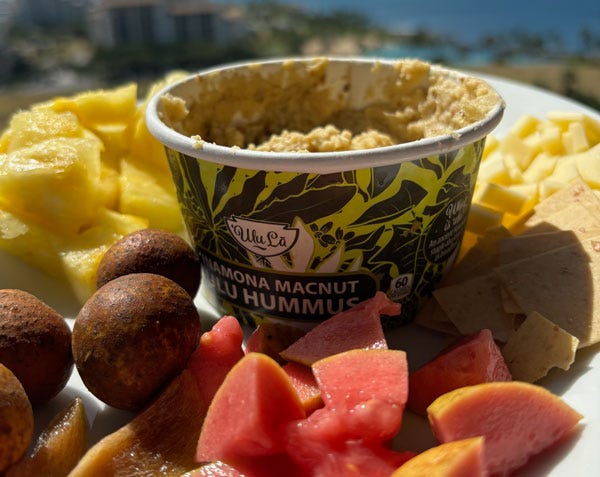
For the first part of our trip, we stayed at Aulani, a Disney Resort and Spa at the western edge of Oahu, far from the main tourist zones. We were lucky enough to have a room with a kitchen and spent a lot of time in there. Some of our local fruit, like bananas and pineapple weren’t quite ready when they got delivered, but our room faced South, so we placed them on our balcony to ripen in the sun.
Much like learning our new home kitchen, we had to figure out how to cook at our resort without the usual comforts of home. We had a handful of pots and pans, a plastic cutting board, and a small paring knife. But we also had a full size stove and oven and we figured out how to stretch everything.
Right after our plane landed, we stopped at a local organic food shop called Down to Earth. I was delighted to find a selection of local produce, although we didn’t buy much because our Farm Link order was arriving the next day. Down to Earth even advertised that 52% of their produce section was from local suppliers! (I recognized MA’O Organic Farms on their shelf and picked up some Hawaiian organic Thai basil).
The next day, our Farm Link driver met us at the front door of our resort and dropped off two huge boxes full of amazing local goodies! We began to dive in right away.
Our hotel had gas grills available for guests to use, so I set to grilling us local grass fed burgers for lunch. The restaurant steps away was also serving burgers, yet I had no idea where their meat came from or what it might be treated with. As I brought my plate of cooked burgers into the elevator, another guest commented that I probably saved $100 grilling my own burgers. He was probably right.
For the rest of our stay at Aulani, we indulged in amazing fresh fruits and vegetables and cooked with local mushrooms, shrimp, and hot sauce. We made a delicious stir fry dish with noodles for dinner, then saved the shrimp shells to make a soup for lunch the next day.
After our time at Aulani, we joined friends who were renting a condominium closer to Waikiki Beach that also had a full kitchen. We showed up with so much food that a bellman had to help us to the room because we couldn’t carry both our luggage and the food. The kitchen was big and beautiful, but it was also equipped with an assortment of kitchen utensils, not all of them super functional.
We realized right away that there was only a Keurig coffee maker. I tend to avoid Keurig in general, but Hawai’i is also one of the only states where coffee can grow, and I wasn’t going to miss drinking Hawaiian coffee on our visit.
I came up with a system for making coffee that involved making hot (but not boiling) water in one large pot, then using a ladle to slowly pour the water through a fine mesh strainer and coffee filter with local coffee grounds, before landing in a second pot. It was time consuming, but it made some damn good coffee!
Cooking for friends in an unfamiliar kitchen was so much fun. My wife and I loved making big breakfasts in the morning for everyone, which included her gluten free pancakes, fresh fruit, eggs, coffee, and much more. We also cooked some amazing dinners.
I had never cooked in such a high end kitchen before and was intrigued by some of the features. For example, the gas range simply lit when the knob was turned on. There was no “light” setting and none of the clicking that I associate with a gas stove. Ditto for the gas grills at both Aulani and the condo: simply turn the switch to “high” and the grill fired up without any ignition button. What is this sorcery?!
I also learned some things about flavoring. For example, we didn’t have garlic for much of the trip, but had picked up some garlic sauerkraut at Down to Earth (if you didn’t know, I love sauerkraut). The garlic flavor from the kraut added flavor to our dishes without needing garlic.
At Down to Earth, we had purchased maybe 2-3 tablespoons of sea salt from their bulk section, but it ended up not being quite enough to season our dishes for the week.
In a jet lagged daze on the first morning of our trip, I found myself in the local Foodland supermarket when they opened at 5:00am. I picked up a few essentials, then found an organic nori furikake seasoning (a Japanese mix made with sesame seeds, salt, and seaweed that’s popular in Hawai’i). The furikake ended up being the topping for most of our dishes, including breakfast sweet potatoes and eggs, and it provided the salt that would otherwise have been missing.
In cooking in so many new kitchens over the last week or so and in trying to make delicious and somewhat ambitious meals in them, I’ve learned that it’s okay to experiment with food. I used to be very strict about following recipes and having exactly the right ingredients on hand to make a dish. Now that I’ve learned some basic techniques and am willing to experiment, I feel confident to try anything. (Of course, it doesn’t hurt having my wife working with me, who is also an amazing cook).
I often think back to something I heard U.K. chef Jamie Oliver say on one of his shows years ago. I don’t remember the exact quote, but the gist was that if you cook with fresh, high quality ingredients, you can make simple dishes that taste amazing. We saw that firsthand in Hawai’i: working with fresh produce from the island elevated our meals in a noticeable way.
I also learned from Alejandra Ramos when she was on my podcast a few years ago that presentation of home meals is just as important as restaurant meals. Dressing each dish with a little sauerkraut, furikake, or microgreens elevated basic meals to restaurant quality.

The friends we were staying with loved eating meals that my wife and I cooked, and we loved the adventure of learning a new space and figuring out how to make do with the tools we had on hand. Even our new home kitchen will one day be familiar, but for now, every meal is an adventure.
Thanks for reading Willoughby Hills! Subscribe for free to receive new posts and support my work.
Related Reading
A Diet That Works! (*at least for me)
If you’ve missed past issues of this newsletter, they are available to read here.






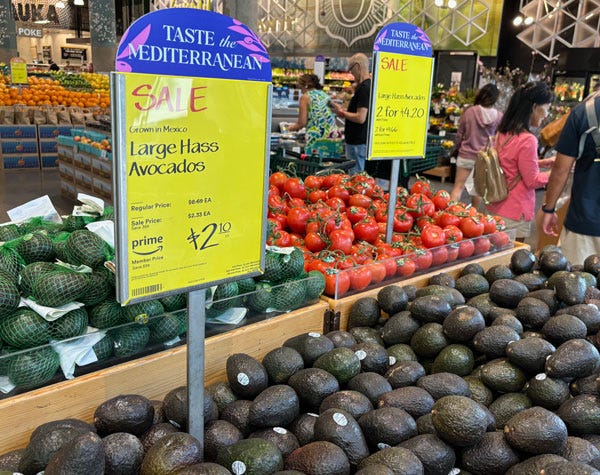





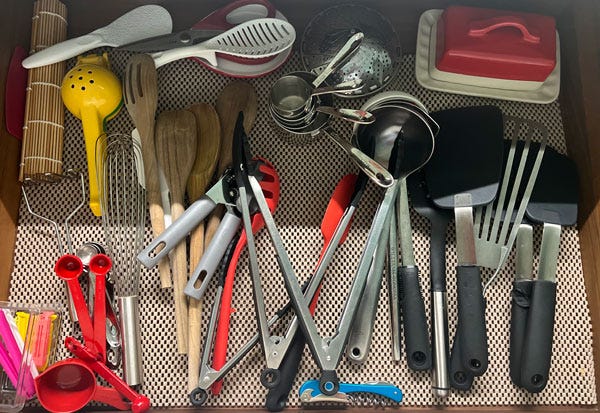

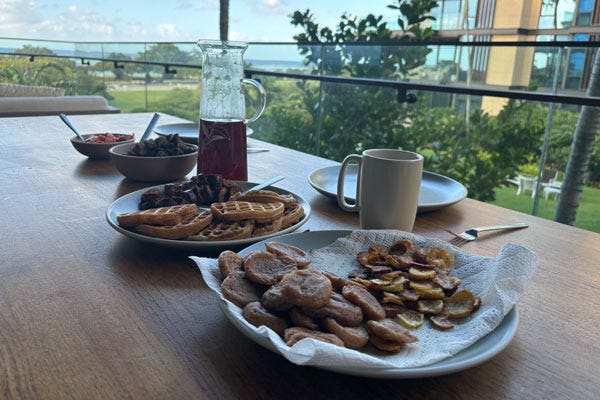
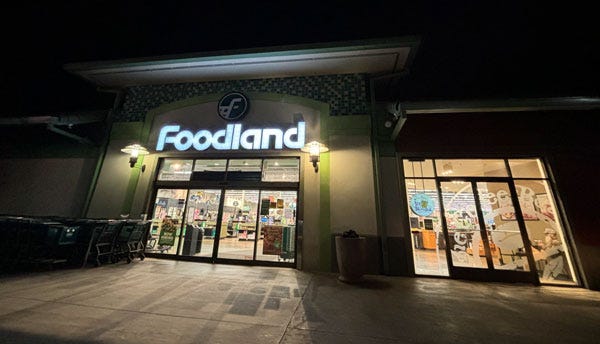
I had no idea you were documenting your food journey during your trip! Hearing you tell us about the process of procuring ingredients is one thing but reading about it and seeing it in photos makes it come to life! We miss your shrimp shell stock and Seema's cassava flour croquettes!
I swear I can smell that local coffee you were brewing when I saw that picture of you carefully ladling hot water over the grinds... What a wonderful treat to be eating all local produce and meats. Congrats on finally moving into the new home!